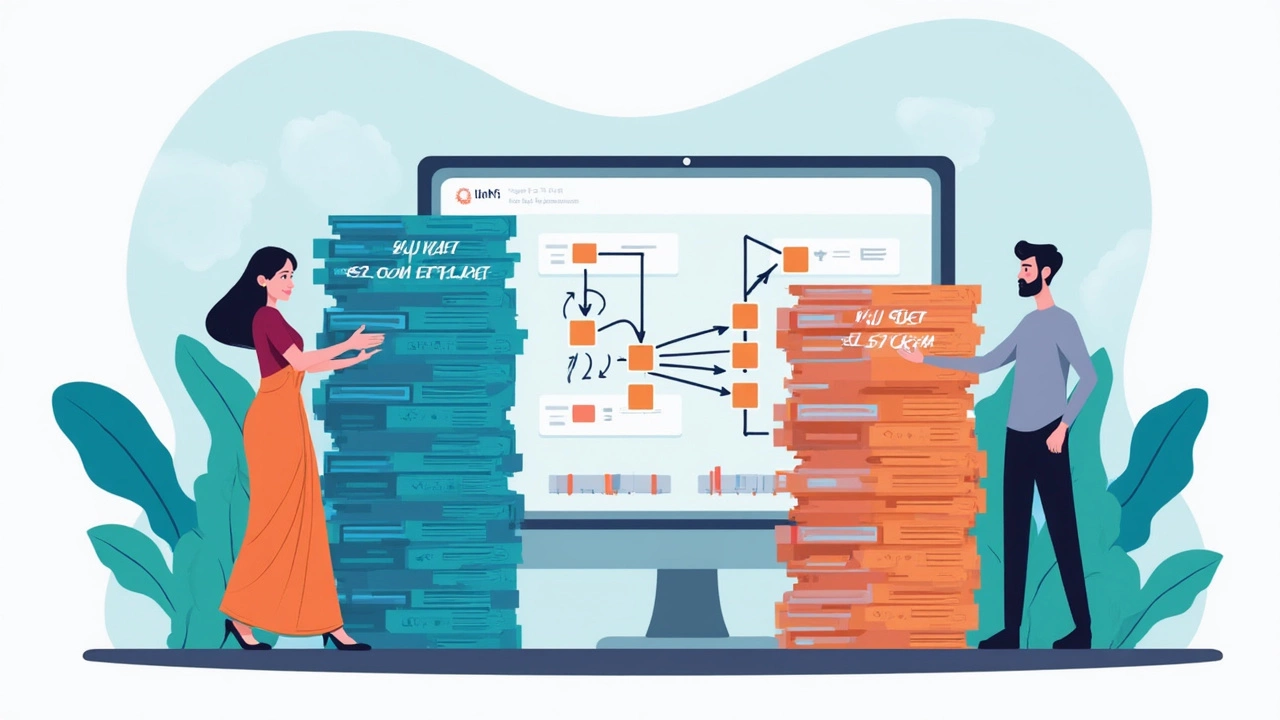
Ever wonder why some online courses are a breeze to use while others make you want to toss your laptop out the window? Two terms are behind a lot of this: LMS and SCORM. People toss these around like they're the same thing, but they play totally different roles in e-learning. Knowing the difference can save you hours of frustration—and maybe a bit of your sanity—when it comes to picking or using training platforms.
If you’ve ever uploaded a course somewhere and gotten the dreaded 'unsupported file type' error, SCORM is often the culprit. Or if you want to see which of your employees actually finished a compliance module (instead of just clicking through), you’re talking LMS territory. These aren’t just tech buzzwords—they’re the backbone of how online courses are delivered and tracked. Getting them straight can make your digital training run a whole lot smoother.
- What Does LMS Mean?
- The Nitty-Gritty on SCORM
- How LMS and SCORM Work Together
- Common Misunderstandings Cleared Up
- Tips for Picking LMS and SCORM Solutions
What Does LMS Mean?
An LMS—that’s short for Learning Management System—is basically the hub where all your digital learning happens. Think of it as the control center for your online courses, videos, quizzes, and everything else you use to train or teach people online. If you’ve ever logged into a company portal to complete an onboarding class or clicked through a compliance course at work, you were probably using an LMS.
LMS platforms help organizations track, deliver, and manage online training. They make it possible to see who finished which course, how well they did, and if they need more help. Trainers and instructors can upload content, set up pathways for learning, and even automate reminders for folks who forget to finish their courses.
Here’s what a solid LMS will usually handle:
- User management—keeping track of who’s assigned to what course.
- Course delivery—letting learners access materials 24/7 from anywhere.
- Testing and quizzes—building in quizzes that show if someone actually learned the stuff.
- Progress tracking—monitoring who’s completed what and generating useful reports.
- Compliance tracking—critical for industries like healthcare and finance where records matter.
Some popular examples in the e-learning world are Moodle, Canvas, and Blackboard. You might recognize these from college, but tons of businesses use them too. According to a 2023 industry survey, over 75% of businesses with more than 500 employees use some kind of LMS for training and compliance.
The best part? A good LMS makes learning and tracking super simple—which means less stress for HR and more useful training for everyone else.
The Nitty-Gritty on SCORM
SCORM stands for Sharable Content Object Reference Model. It sounds complicated, but really, SCORM is a set of standards that tell e-learning courses how to talk to a LMS. It’s like those universal plugs that let your charger work in different countries. If your course is built using SCORM, you can upload it to just about any major e-learning platform, and it should work without a hitch.
So what does SCORM actually do? It helps with things like tracking progress, remembering where you left off, recording quiz scores, and even marking a lesson as complete. This is huge if you want your online training to actually count for something, like a required certification or compliance training. The first version, SCORM 1.1, came out in 2000, and since then it’s stuck around because it keeps everything simple and standardized for course creators and admins.
Here’s what SCORM really brings to the table:
- Plug-and-play compatibility: Courses work across most LMS platforms.
- Consistent tracking: Every learner’s progress and results can be tracked and reported back to the LMS without fancy custom coding.
- Resuming: SCORM remembers where a learner left off. No need to start over.
- Standard data reporting: Get info on completions, scores, and time spent. Super useful for training managers.
Almost every Fortune 500 company uses SCORM to manage their digital education content because it just works. Take a look at these stats about SCORM’s popularity:
| Year | % of LMS Platforms Supporting SCORM |
|---|---|
| 2015 | 78% |
| 2020 | 92% |
| 2024 | 94% |
But heads up: SCORM isn’t perfect. It’s not the latest tech anymore, and gets a little clunky with mobile learning or simulations. If you’re building super interactive, modern courses, you might hit limits. Still, for basic tracking and mass compatibility, SCORM is the gold standard you’ll see everywhere in online training.

How LMS and SCORM Work Together
Picture your LMS as the main hub—the dashboard where all your online courses live, and where users log in to track their progress. Now, think of SCORM as the instructions that tell this hub exactly how to import, launch, and track those courses. One can’t really do its best job without the other if you want smooth, trackable learning experiences.
Here’s how things play out: when a training course or module is built to be SCORM-compliant, you get a .zip package containing all the course files and a small XML file packed with instructions. The LMS reads that package and instantly knows what to do—where to start, how to track progress, and what quiz scores to record. If a team member exits halfway through a lesson, the LMS can remember where they stopped and let them pick up from there, all because of SCORM.
Most modern e-learning systems support SCORM in some way. In fact, a 2023 global survey found that around 80% of companies using online training tools rely on either SCORM 1.2 or SCORM 2004 formats for compatibility. The other formats barely get a look-in because SCORM is kind of the universal handshake for sharing e-learning content between platforms.
| Step | Role of LMS | Role of SCORM |
|---|---|---|
| Upload Course | Lets you add content | Tells LMS what files are needed |
| Launch Lesson | Opens course for users | Ensures content shows up as intended |
| Track Progress | Keeps score and logs activity | Passes completion and quiz data to LMS |
| Resume Learning | Remembers where users stopped | Stores bookmark data in course package |
One quick tip: Before building your own content, always double-check which SCORM versions your LMS can handle. Some only work with SCORM 1.2, while others also handle SCORM 2004 or even xAPI, which opens up more tracking options. If you skip this step, you risk wasting time on courses that your LMS can’t even open.
In short, a SCORM-compliant course and a SCORM-ready LMS make online training easy to track, easier to report on, and way less stressful when it’s time for audits or compliance checks.
Common Misunderstandings Cleared Up
Let’s be real—mixing up LMS and SCORM happens all the time. Loads of folks think SCORM is just another word for an online course, or that you have to pick between an LMS and SCORM. That’s not how it works at all.
First off, SCORM isn’t a platform. It’s really just a set of standards for making e-learning content and making sure it talks nicely with different systems. If you think of the LMS as the theater, SCORM is the script that actors (the courses) use so the show doesn’t go off the rails.
Another common mix-up: people sometimes believe every e-learning platform supports SCORM. That’s just not true. While most modern LMS options say they are SCORM-compliant, you still have to check the fine print. Some platforms only support specific versions of SCORM (like 1.2 or 2004), and not all SCORM features work everywhere. If your course needs advanced tracking or special quiz settings, those might not show up right on every LMS.
There’s also this idea that SCORM automatically makes courses better or more interactive. Actually, it just helps your course track things like completion, scores, or time spent. SCORM doesn’t care how pretty your slides are or if your video is crystal clear. That’s totally up to the content creator and the tools you use.
Misunderstandings get even messier when it’s time to get reports. Just because you’ve got a SCORM course uploaded to your LMS doesn’t mean you’ll get every single data point you might want. Tons of LMS platforms only pull basic stuff: completed or not, score, and maybe how long someone spent. Here’s a snapshot of what’s usually tracked:
| Tracked by SCORM | How It Shows Up in Most LMS |
|---|---|
| Course Completion | Yes |
| Pass/Fail Status | Yes |
| Quiz Scores | Usually |
| Time Spent | Sometimes |
| Detailed Quiz Answers | Rarely |
The last big myth: once a course works in one LMS, it’ll just work perfectly everywhere. Not exactly. Differences in how SCORM is implemented mean you might run into bugs, broken graphics, or lost progress info when switching platforms. Always do a test before rolling out your courses to everyone.
If you can clear up these common misunderstandings, you won’t waste time chasing tool features that don’t exist—or worse, spend weeks building content only to learn it doesn’t work on your organization’s LMS.

Tips for Picking LMS and SCORM Solutions
Choosing the right LMS and SCORM setup isn’t just about chasing the latest trend or picking the one with the fanciest dashboard. You want tools that actually work for your team, your courses, and save you headaches later.
Here’s what you want to look out for:
- SCORM Compatibility: Not all learning management systems play nice with SCORM. Always double-check if the LMS fully supports SCORM 1.2, 2004, or both. Some platforms just pay lip service, but real compatibility means courses launch and track properly every time.
- User Experience: Try out the platform as both a learner and admin. Is it easy to upload, update, and organize your SCORM courses? A clunky interface wastes time every single day.
- Tracking and Reporting: Make sure the LMS gives you detailed tracking—like completion rates, quiz scores, and how long folks spend on each module. The real value of SCORM is in this data. If the reports are basic or hard to export, keep shopping around.
- Mobile Access: Over half of all e-learning now happens on mobile devices. Your LMS should let people take SCORM courses on a phone or tablet without issues. Ask for a test drive on mobile before signing up.
- Integrations: Does the LMS play well with your other software, like HR systems or video conferencing? It can be a pain to juggle logins or move data manually.
- Support and Updates: A top LMS vendor will answer your emails quickly and roll out updates often, especially for keeping up with security or new SCORM features.
- Pricing Structure: Some platforms charge by user, by bandwidth, or by number of courses. Don’t get locked into an expensive tier you don’t need. Always ask for clear pricing up front.
Check out this quick comparison of popular LMS platforms and their SCORM support:
| LMS Platform | SCORM 1.2 | SCORM 2004 | Mobile Friendly | Notable Feature |
|---|---|---|---|---|
| Moodle | Yes | Yes | Yes | Open-source, big community |
| TalentLMS | Yes | Yes | Yes | Easy setup, drag & drop |
| Blackboard | Yes | Yes | Yes | Widely used in universities |
| Absorb LMS | Yes | Yes | Yes | Great analytics |
One last tip: talk to other e-learning managers before making a choice. They’ll often share real experiences that you can’t find in glossy sales brochures. And before you roll out new software across your organization, test it with a small pilot group first. They’ll find the weird glitches and save you from a big launch-day mess.





